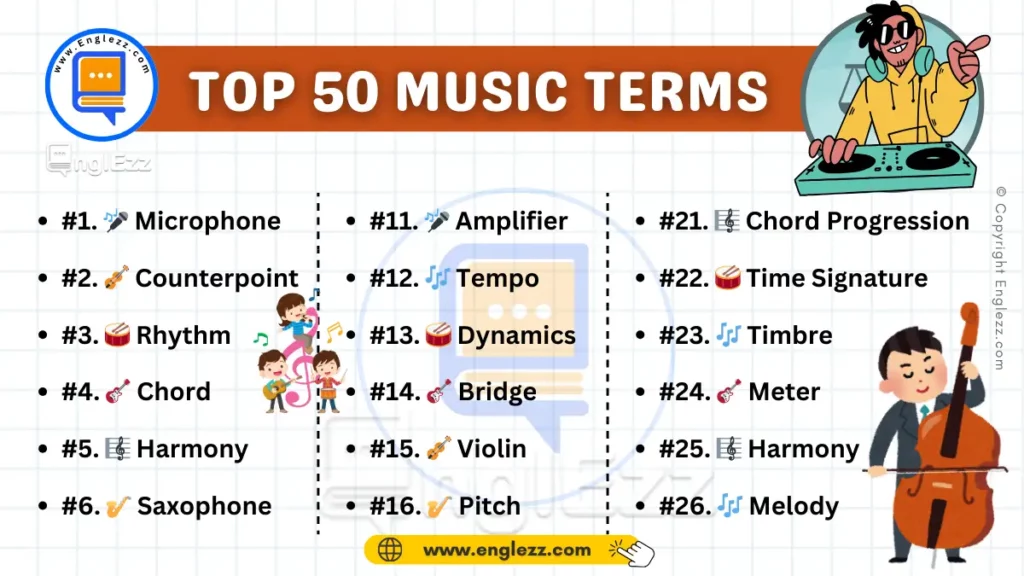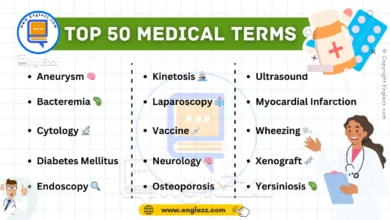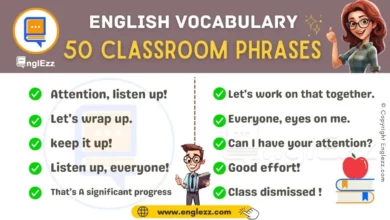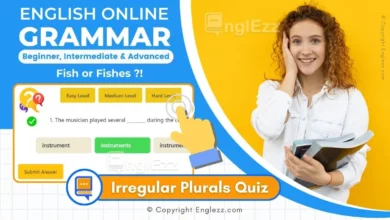Music is a universal language, but understanding the terminology that goes with it can sometimes feel like deciphering a complex code.
In this blog post, we’ll explore 50 of the most common English terms related to music. Each term is explained with its definition, phonetic transcription, and examples that illustrate how they are used in real-life scenarios.
50 Music English Terms Every Student Must Know
Whether you’re a budding musician, a music lover, or someone working within the industry, knowing the right terms can make a world of difference. From understanding what “crescendo” means to knowing the role of a “bass” in a band, each term contributes to a richer understanding of music and its nuances.
This comprehensive guide is designed to help you not only expand your music vocabulary but also improve your ability to communicate about music with confidence.
So whether you’re writing lyrics, discussing your favorite band, or simply expanding your knowledge, these terms will equip you with the language you need to express your passion for music. Let’s dive into the world of music terminology and start your journey toward mastering the language of music! 🎧
#1. 🎤 Microphone [ˈmaɪkroʊˌfoʊn]
Definition: A device used to amplify or record sounds. Examples:
- The singer adjusted the microphone before starting the performance.
- You need to speak into the microphone for your voice to be heard clearly.
#2. 🎶 Melody [ˈmɛlədi]
Definition: A sequence of notes that are musically satisfying; the main theme of a piece of music. Examples:
- The melody of that song is so catchy, it stays in your head all day.
- She hummed a sweet melody as she walked down the street.
#3. 🥁 Rhythm [ˈrɪðəm]
Definition: A strong, regular repeated pattern of movement or sound in music. Examples:
- The drummer kept a steady rhythm throughout the song.
- Dance music is often characterized by its upbeat rhythm.
#4. 🎸 Chord [kɔrd]
Definition: A group of notes played together to create harmony. Examples:
- He strummed a G chord on his guitar.
- The song begins with a series of soft chords.

#5. 🎼 Harmony [ˈhɑrməni]
Definition: The combination of simultaneously sounded musical notes to produce a pleasing effect. Examples:
- The choir sang in perfect harmony.
- The harmony between the instruments was flawless.
#6. 🎻 Violin [ˌvaɪəˈlɪn]
Definition: A string instrument that is played with a bow. Examples:
- She has been playing the violin since she was six years old.
- The violin solo was the highlight of the performance.
#7. 🎷 Saxophone [ˈsæksəˌfoʊn]
Definition: A woodwind instrument that is commonly used in jazz music. Examples:
- The saxophone player performed a soulful solo.
- He bought a new saxophone to play in the jazz band.
#8. 🎺 Trumpet [ˈtrʌmpɪt]
Definition: A brass musical instrument with a bright, penetrating tone. Examples:
- The trumpet section sounded fantastic in the orchestra.
- She plays the trumpet in the school band.
#9. 🎧 Acoustics [əˈkuːstɪks]
Definition: The properties or qualities of a room or building that determine how sound is transmitted. Examples:
- The acoustics in this concert hall are amazing.
- Poor acoustics made it difficult to hear the singer clearly.
#10. 🎵 Bass [beɪs]
Definition: The lower range of sounds in music, typically provided by instruments such as the bass guitar. Examples:
- The bass line in this track is really powerful.
- He plays bass in a rock band.
#11. 🎤 Amplifier [ˈæmplɪˌfaɪər]
Definition: An electronic device used to increase the strength of audio signals. Examples:
- The guitarist adjusted the amplifier to get a louder sound.
- The amplifier helped to fill the stadium with sound.
#12. 🎶 Tempo [ˈtɛmpoʊ]
Definition: The speed at which a passage of music is played. Examples:
- The conductor asked the orchestra to increase the tempo.
- The tempo of this song is perfect for dancing.
#13. 🥁 Dynamics [daɪˈnæmɪks]
Definition: The volume of sound in a musical performance, ranging from soft to loud. Examples:
- The dynamics of the piece create an emotional journey.
- He played the piano with such dynamic contrast, moving from soft to loud seamlessly.
#14. 🎸 Bridge [brɪdʒ]
Definition: A transitional section in a piece of music that contrasts with the verse and chorus. Examples:
- The bridge added an interesting twist to the song.
- After the second chorus, the band moved into the bridge.
#15. 🎼 Key [ki]
Definition: The group of pitches, or scale, that forms the basis of a music composition. Examples:
- This song is written in the key of C major.
- The key change in the chorus adds excitement to the song.
#16. 🎻 Pitch [pɪtʃ]
Definition: The quality of a sound determined by the frequency of the waves producing it; how high or low a note sounds. Examples:
- The singer hit a perfect pitch on the high note.
- Tuning the instrument helps to correct its pitch.
#17. 🎷 Syncopation [ˌsɪŋkəˈpeɪʃən]
Definition: A musical rhythm in which stress is placed on the weak beats instead of the strong beats. Examples:
- The syncopation in jazz music gives it a unique feel.
- The drummer used syncopation to create a complex rhythm.
#18. 🎺 Crescendo [krəˈʃɛndoʊ]
Definition: A gradual increase in loudness in a piece of music. Examples:
- The music reached a crescendo at the climax of the piece.
- The conductor signaled for a crescendo, and the orchestra responded beautifully.
#19. 🎧 Modulation [ˌmɒdʒəˈleɪʃən]
Definition: The process of changing from one key to another in music. Examples:
- The modulation from C major to G major was smooth.
- This song features a surprising modulation near the end.
#20. 🎵 Octave [ˈɑktɪv]
Definition: The interval between one musical pitch and another with half or double its frequency. Examples:
- The singer’s voice spans three octaves.
- He played the melody an octave higher.
#21. 🎤 Chord Progression [kɔrd prəˈɡrɛʃən]
Definition: A series of chords played in a sequence. Examples:
- The chord progression in this song is quite common in pop music.
- She wrote a beautiful chord progression for her new composition.
#22. 🎶 Timbre [ˈtæmbər]
Definition: The quality of a musical note or sound that distinguishes different types of sound production. Examples:
- The timbre of the violin is distinct from that of the viola.
- Her voice has a warm timbre that is very pleasing to the ear.
#23. 🥁 Time Signature [ˈtaɪm ˌsɪɡnətʃər]
Definition: A notational convention used in music to specify how many beats are in each measure and which note value is equivalent to one beat. Examples:
- The time signature of this piece is 4/4.
- Changing the time signature can dramatically alter the feel of a song.
#24. 🎸 Meter [ˈmiːtər]
Definition: The structured pattern of rhythm in a piece of music, typically defined by the time signature. Examples:
- This song is in a triple meter, which gives it a waltz-like feel.
- The meter of the song shifts in the middle section, adding complexity.
#25. 🎼 Harmony [ˈhɑrməni]
Definition: The combination of different musical notes played or sung simultaneously to produce a pleasing sound. Examples:
- The harmony between the voices was perfect.
- Adding harmony to the melody enriched the overall sound.
#26. 🎻 Counterpoint [ˈkaʊntərˌpɔɪnt]
Definition: The technique of combining two or more independent melodies to create harmony. Examples:
- The counterpoint in Bach’s compositions is masterful.
- This piece features an intricate counterpoint between the violin and piano.
#27. 🎷 Arpeggio [ɑːrˈpɛdʒioʊ]
Definition: The notes of a chord played in succession, either ascending or descending. Examples:
- She played an arpeggio on the piano to warm up her fingers.
- The guitarist added an arpeggio to give the song a classical touch.
#28. 🎺 Cadence [ˈkeɪdəns]
Definition: A sequence of notes or chords that signifies the end of a phrase or piece of music. Examples:
- The piece ended with a strong cadence in the key of D.
- A deceptive cadence kept the listeners on edge.
#29. 🎧 Legato [lɪˈɡɑtoʊ]
Definition: A smooth and connected style of playing or singing, with no breaks between the notes. Examples:
- The pianist played the piece legato, giving it a flowing feel.
- She sang the line legato, seamlessly moving from note to note.
#30. 🎵 Staccato [stəˈkɑtoʊ]
Definition: A style of playing notes in a short, detached manner. Examples:
- The staccato notes added a playful rhythm to the melody.
- The conductor instructed the orchestra to play the passage staccato.
#31. 🎤 Forte [ˈfɔrteɪ]
Definition: A dynamic marking indicating that a passage of music should be played loudly. Examples:
- The music suddenly shifted to forte, surprising the audience.
- He played the final chord with a strong forte.
#32. 🎶 Pianissimo [piəˈnɪsɪˌmoʊ]
Definition: A dynamic marking indicating that a passage of music should be played very softly. Examples:
- The pianist played the ending pianissimo, creating a delicate finish.
- The orchestra began the piece with a pianissimo section, barely audible.
#33. 🥁 Accidental [ˌæksɪˈdɛntəl]
Definition: A note in a piece of music that is not part of the key signature, indicated by a sharp, flat, or natural sign. Examples:
- The accidental in the second measure adds tension to the melody.
- He missed the accidental and played the wrong note.
#34. 🎸 Clef [klɛf]
Definition: A symbol at the beginning of the staff that indicates the pitch of the notes on the staff. Examples:
- The treble clef indicates that the notes are higher in pitch.
- The bass clef is used for lower-pitched instruments.
#35. 🎼 Coda [ˈkoʊdə]
Definition: A concluding passage of a piece of music, typically forming an addition to the basic structure. Examples:
- The symphony ends with a powerful coda.
- The band played a brief coda to wrap up the performance.
#36. 🎻 Tonic [ˈtɑnɪk]
Definition: The first note of a scale, serving as the home base or focal point of a piece of music. **Examples:
- The piece resolves on the tonic, providing a sense of closure.
- The melody frequently returns to the tonic note.
#37. 🎷 Dissonance [ˈdɪsənəns]
Definition: A combination of notes that clash, creating tension in the music. Examples:
- The dissonance in this piece makes it feel unsettling.
- The composer used dissonance to convey the chaotic emotions of the scene.
#38. 🎺 Consonance [ˈkɒnsənəns]
Definition: A combination of notes that are in harmony with each other, creating a pleasing sound. Examples:
- The consonance of the chords made the piece sound peaceful.
- The song resolves with a beautiful consonance.
#39. 🎧 Interval [ˈɪntərˌvəl]
Definition: The difference in pitch between two notes. Examples:
- The interval between C and E is a major third.
- He practiced singing intervals to improve his pitch accuracy.
#40. 🎵 Rondo [ˈrɒndoʊ]
Definition: A musical form with a recurring leading theme, often used in the final movement of a sonata or concerto. Examples:
- The rondo form keeps the piece lively and engaging.
- The composer returned to the main theme in the rondo section.
#41. 🎤 Sostenuto [ˌsoʊstəˈnuːtoʊ]
Definition: A direction to play a note or chord in a sustained manner. Examples:
- The pianist held the chord sostenuto for dramatic effect.
- The sostenuto passage created a sense of anticipation.
#42. 🎶 Vivace [viˈvɑːtʃeɪ]
Definition: A tempo marking indicating that a passage of music should be played in a lively and fast manner. Examples:
- The orchestra played the vivace section with great energy.
- The piece begins vivace, immediately grabbing the audience’s attention.
#43. 🥁 Glissando [ɡlɪˈsændoʊ]
Definition: A continuous slide upwards or downwards between two notes. Examples:
- The violinist played a glissando from G to C.
- The glissando on the piano added a dramatic flair to the performance.
#44. 🎸 Trill [trɪl]
Definition: A musical ornament consisting of a rapid alternation between two adjacent notes. Examples:
- The flutist added a trill to the final note for emphasis.
- The trill gave the melody a lively character.
#45. 🎼 Allegro [əˈlɛɡroʊ]
Definition: A tempo marking indicating that a passage of music should be played quickly and brightly. Examples:
- The symphony’s first movement is marked allegro.
- The piece ends with an allegro section that lifts the mood.
#46. 🎻 Adagio [əˈdɑːdʒioʊ]
Definition: A tempo marking indicating that a passage of music should be played slowly and gracefully. Examples:
- The adagio movement of the symphony is very expressive.
- The orchestra performed the adagio with deep emotion.
#47. 🎷 Pizzicato [ˌpɪtsɪˈkɑtoʊ]
Definition: A technique where the strings of an instrument are plucked with the fingers. Examples:
- The cellist used pizzicato to create a playful rhythm.
- The pizzicato section added a light texture to the music.
#48. 🎺 Fermata [fərˈmɑːtə]
Definition: A symbol indicating that a note or rest should be held longer than its usual duration. Examples:
- The conductor signaled a fermata, holding the final note for extra emphasis.
- The fermata in the middle of the piece created a dramatic pause.
#49. 🎧 Leger Line [ˈlɛʒər laɪn]
Definition: A short line added above or below the staff to extend its range. Examples:
- The note was so high, it required a leger line above the staff.
- Leger lines allow musicians to play notes beyond the normal range of the staff.
#50. 🎵 Syncopation [ˌsɪŋkəˈpeɪʃən]
Definition: A rhythm where the emphasis is placed on the off-beat or weak beat. Examples:
- Jazz music often features syncopation, giving it a unique swing.
- The syncopation in this piece makes it feel lively and unpredictable.
Music English Terms Table
| #1. 🎤 Microphone | #11. 🎤 Amplifier | #21. 🎼 Chord Progression |
| #2. 🎶 Melody | #12. 🎶 Tempo | #22. 🎶 Timbre |
| #3. 🥁 Rhythm | #13. 🥁 Dynamics | #23. 🥁 Time Signature |
| #4. 🎸 Chord | #14. 🎸 Bridge | #24. 🎸 Meter |
| #5. 🎼 Harmony | #15. 🎻 Violin | #25. 🎼 Harmony |
| #6. 🎷 Saxophone | #16. 🎷 Pitch | #26. 🎻 Counterpoint |
| #7. 🎺 Trumpet | #17. 🎷 Syncopation | #27. 🎷 Arpeggio |
| #8. 🎧 Acoustics | #18. 🎺 Crescendo | #28. 🎺 Cadence |
| #9. 🎵 Bass | #19. 🎧 Modulation | #29. 🎵 Legato |
| #10. 🎤 Amplifier | #20. 🎸 Octave | #30. 🎸 Staccato |
| #31. 🎼 Forte | #32. 🎶 Pianissimo | #33. 🥁 Accidental |
| #34. 🎸 Clef | #35. 🎼 Coda | #36. 🎻 Tonic |
| #37. 🎷 Dissonance | #38. 🎺 Consonance | #39. 🎧 Interval |
| #40. 🎵 Rondo | #41. 🎤 Sostenuto | #42. 🎶 Vivace |
| #43. 🥁 Glissando | #44. 🎸 Trill | #45. 🎼 Allegro |
| #46. 🎻 Adagio | #47. 🎷 Pizzicato | #48. 🎺 Fermata |
| #49. 🎧 Leger Line | #50. 🎵 Syncopation |
Conclusion 🎶
Understanding music terms is like unlocking a new dimension of the musical experience. Whether you’re a musician, a music lover, or someone working within the industry, these 50 music English terms provide a solid foundation for discussing and appreciating music on a deeper level.
As you integrate these terms into your vocabulary, you’ll find yourself more attuned to the nuances of music, whether you’re playing an instrument, singing, or simply listening.
Remember, language shapes our understanding, and by mastering the terminology of music, you’re enhancing not just your communication skills, but also your ability to connect with others who share your passion.
So, the next time you listen to a song, attend a concert, or engage in a discussion about music, you’ll have the vocabulary to express yourself with confidence and clarity. Keep exploring, keep listening, and let the music move you! 🎵









Dive into the world of music with our comprehensive guide on the 50 most common music English terms! 🎶 Whether you’re a musician or just a music enthusiast, understanding these terms will enhance your appreciation and communication about music.
Explore definitions, phonetic transcriptions, and practical examples that bring each term to life. Check out the full post for a symphony of knowledge and don’t forget to follow and like @EnglEzz for more educational content!
.
http://www.englezz.com/?p=19631
.
#EnglEzz #vocabulary #linguistics #learnenglish #music #musictheory #musicianlife #musiclover #education
I do not even know how I ended up here, but I thought this post was great! I dont know who you are but definitely youre going to a famous blogger if you arent already Cheers